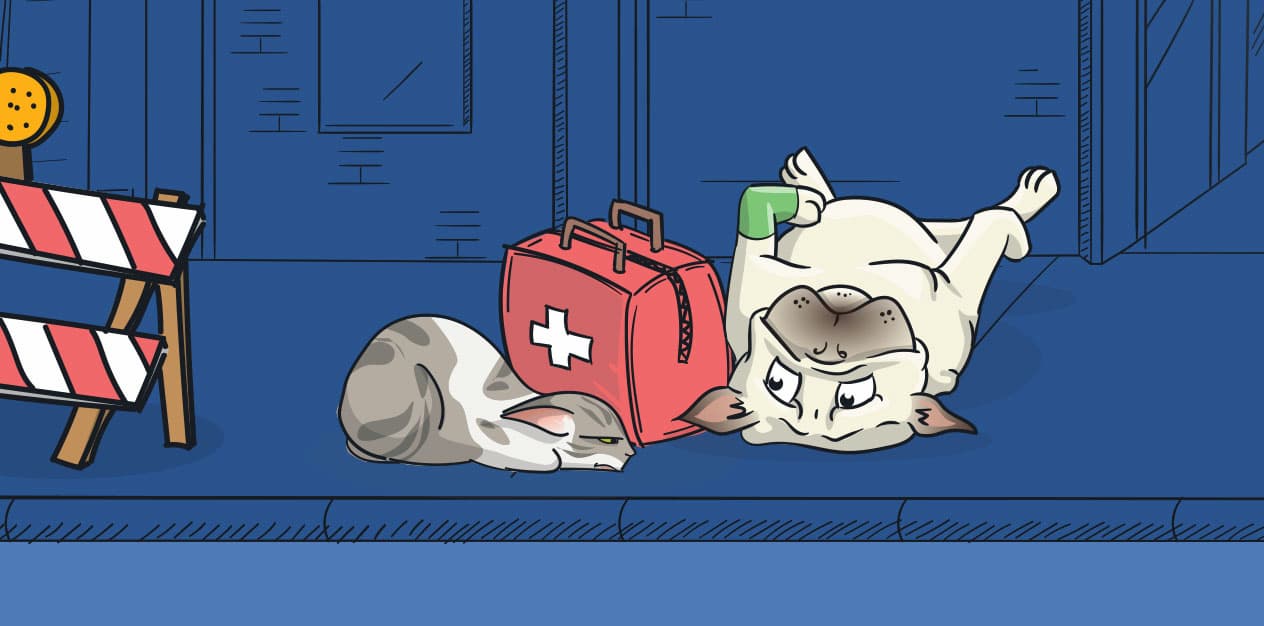

The Complete Guide to Dog and Cat First Aid
Everyone goes through rough times, but no times are rougher for pet parents than when their fur baby suffers a medical emergency. The good news? An appropriate, calm response in such situations can increase their chances of survival and help you function better. So what should you do when the dog or cat doo-doo hits the fan? With the help of our experts, we’ve compiled this first-class first-aid guide.

Writer Roi Kadosh
9 min read

Emergency preparedness – what should you have at home?
Just like some folks ensure they always have a good, larger than necessary supply of food and water for themselves and their family, it’s also advisable to put together a few items as part of a first aid kit for your dog or cat:
- Important phone numbers – a veterinary/emergency center
- Blankets and towels for restraint and for carrying your pet (we’ll specify exactly what to do with them later)
- Bandaging materials – gauzes, elastic bandages
- Antiseptic ointment
- Two packages of cotton wool
- An antiseptic solution (like Betadine)
- A copy of the dog’s/cat’s medical records
- A carrying cage for a cat or dog
- Saline flush
What to do in a pet health emergency?
Regardless of the nature of the injury or wound, there are some basic principles to remember and act upon in an emergency:
- Keep calm – we know this might sound impossible. Still, we can’t stress the importance of coolly assessing the situation enough. Keeping calm while rationally evaluating the situation and the extent of the threat, or additional dangers for you and your pet, can make a huge difference. Dogs and cats easily sense signs of stress – if you lose your cool, they might try to escape from you or become aggressive. Approach them gently, without sudden movements, and speak to them softly and calmly.
- Contact your regular clinic or an emergency center – inform them of the nature of the injury and get first aid tips over the phone. This is exactly why you should have all emergency numbers saved in your phone. Initial instructions from a vet or other experts can address simple questions or prevent well-meaning but ultimately destructive actions.
- Protect yourself – any pet, even your beloved, familiar dog or cat, may act unpredictably when injured or distressed, so approach them cautiously.
- Prevent movement – this is especially important in suspected spinal injuries. In such cases, minimize the movement of the injured animal and place them on a hard surface, like a large board or even a folded table. It’s also advisable to secure them to whatever surface you placed them on using straps or blankets.
- Beware of household medications – remember, your pet isn’t human, no matter how much we treat them like they are, and what’s suitable for human first aid is not necessarily suitable for animals. It’s important to know that some household medications can be very toxic and even lethal to pets – for example, paracetamol can cause severe poisoning and death in cats, and anti-inflammatory drugs like ibuprofen or Advil can cause severe kidney damage in dogs.
- Bring the injured animal to the vet as quickly as possible – even if your dog or cat seems to have calmed down and feels better, it’s essential to take them to a vet for an examination to ensure everything’s okay anyway. Important to know – some injuries (especially internal ones that aren’t visible) can only be detected later. In any emergency, get to an emergency center or nearby veterinary clinic as quickly as possible. At this point, we’d be remiss not to remind you that Animalia Pet Insurance covers treatments in all veterinary clinics across the nation, so even if you need to go to a clinic or emergency center far from your home, treatments will still be covered.

How can you calm injured dogs or cats down?
Emergencies may cause even the calmest and most loving animals to behave aggressively, including towards you, their owner. An injured or wounded dog or cat will usually be frightened and confused. A calm voice may soothe them, but you must still approach or touch them very carefully to prevent being bitten or scratched.
To ensure your safety around injured dogs or cats, you can use several restraint measures:
- A leash, belt, sock, tie, or just a piece of rope can serve as a temporary muzzle. Your dog can still breathe through their nostrils, unless a nasal injury is involved.
- Use a towel or blanket to cover their crate, if you have one. If there’s no crate, you can also try to wrap the head of the scared dog or cat with something, but remember that some animals may panic from such an action.
Possible emergencies and what you can do until your pet receives medical care
Before we delve deeper (and possibly seriously stress you out), we recommend taking a first aid course with an expert and not just taking our word for what needs to be done.
Minor wounds and cuts – first, stop the bleeding by applying direct pressure on the bleeding area with a gauze pad or any other clean cloth. After controlling the bleeding, wash the wound thoroughly with running water and disinfect the area with a disinfectant like Betadine. The use of alcohol is less recommended here, as it burns and can damage wounds. You can also apply a temporary bandage to the wound until you reach the nearest vet. The bandage should both cover and apply pressure to the wound, in order to protect it and control bleeding. Bandages may be applied using standard bandages, towels, washcloths, paper towels, or any clean piece of cloth. Prevent the dog from licking the affected area, as it can increase the damage.
Deep wounds and heavy bleeding – in cases of a deep wound or a heavily bleeding cut, it’s essential to maintain at least 3 minutes of uninterrupted direct pressure to the wound to allow an optimal clotting process that should help stop the bleeding. If bleeding doesn’t stop but responds somewhat to the pressure, continue applying it until you reach medical care. You can perform a tourniquet if the bleeding is in one of the legs and cannot be stopped with direct pressure. Do be aware, though, that this may hamper blood flow to the limb to the point that it later needs to be amputated. However, please only apply a tourniquet if a pet first aid professional has trained you. If you know how to do it, tie a piece of cloth above the bleeding wound with the minimal force necessary to stem the bleeding, or at least significantly weaken it.
Various fractures – if you notice swelling in the affected area and the dog or cat refuses to step on the limb in question, they may be suffering from a fracture. In this case, minimize their movement and transport them to care as soon as possible, preferably by carrying them on a hard surface or in a closed cage or crate.
If the dog or cat is not breathing – check if there’s some kind of discharge blocking the animal’s airway. Be careful doing this, though, as they might bite. If there’s any doubt, you can skip this step before starting mouth-to-mouth resuscitation by blowing air directly into their nose until their chest expands. Note that our lung capacity is much larger than that of most animals, so be careful not to over-inflate – blow only until the chest rises. For small dogs and cats, this means enough air to fill your cheeks (as is the norm in resuscitation performed on babies and small children). Perform this every 4-5 seconds until a vet arrives. You’ll need to alternate this with chest compressions.
If your pet has no pulse – dogs and cats’ pulse may be checked in two main ways:
- By direct palpation of the heart area on the left side of the chest is accessible in smaller animals but can be problematic in larger ones, especially those with excess weight.
- By palpation of the femoral artery – the one that runs inside the groin area. Look for it between the hip and thigh on the side, facing inward, towards the belly.
If there’s no pulse, start chest compressions:
- For medium and large dogs, press down on the chest area, adjusting the force to the dog’s size. If possible, keep your hands straight and have several people take alternating parts.
- For small dogs and cats, cradle the heart so that your fingers are under the chest and your thumb is on top, pressing the heart area between the fingers and thumb. This is done to avoid exerting too much pressure and causing damage that could worsen the situation. Perform CPR at an average rate of 100 compressions per minute – an easy way to remember this is to “pump” to the beat of the song “Stayin’ Alive” by the Bee Gees (which is also recommended for humans nowadays, incidentally).
Burns – rinse the burn area with room temperature (not cold) running water and seek immediate veterinary care.
How can you transport an injured dog or cat to the clinic?
It’s better to transport a small dog or cat in a carrying cage – and larger dogs in a flight crate if possible. In cases of suspected traumatic injury, especially to the spine, it’s essential to try to transport the animal with minimal movement of their body. Use a hard board that simulates a stretcher, such as a transport cart, wooden board, table plate, folding table, etc. If something like that isn’t available, you can improvise a stretcher with a blanket pulled on both sides. For large animals, it’s also recommended to get help from as many people as possible when carrying them, if at all possible.
Whatever health or medical emergency your pet suffers, Animalia Pet Insurance has your back. Your dog or cat will enjoy extensive, first-rate coverage that’ll help ensure both you and them make it out in one piece on the other side – both physically and financially.





We offer the most
comprehensive coverage
out there
car with a spare tire for life’s bumps.
Having Animalia is like a pimped-out
Rolls Royce with a swimming pool
in the trunk.



Get your pet insurance quote
Pet type
- Dog
- Cat
What is your pet's name?
Zip code






